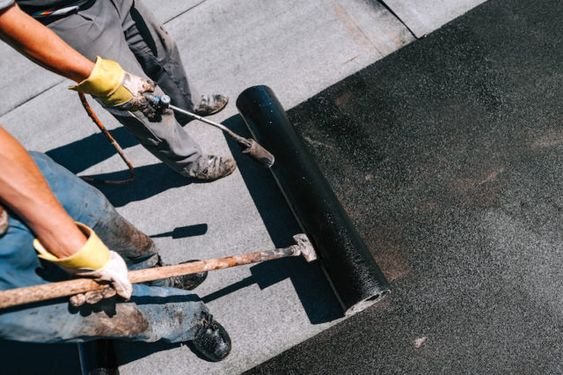High quality rubber roofing is often one of the most effective ways of protecting your property from severe effects of elemental forces. The most experienced roof repair specialists Philadelphia recommend several maintenance tips while elaborating the essentials, advantages, uses and types of rubber roofing in this article.
Fundamentals of rubber roofing
Before delving into the interesting details of what makes rubber such a preferred roofing material, let’s understand what exactly it is and the purpose that it serves.

What is rubber roofing?
Rubber roofing refers to any type of roofing technique or materials comprising several layers of rubber mats. Such mats are usually prevalent among flat-top buildings and structures. The overall roofing may also include rubber shingles, panels and other elements necessary to keep the platform sturdy and in tune with the overall building aesthetic.
An overview of different types of rubber roofing
Rubber roofing Philadelphia is available in single-ply and multi-ply rolls. Moreover, there are three major types to choose from.
EPDM
Also known as Ethylene Propylene Diene Terpolymer, EPDM is one of the most popular roofing materials due to its durability and low cost. It is a naturally black substance but can be customized into whites and grays as well. Usually, adhesives and tapes are used to seal EPDM seams together.
TPO
Also known as Thermoplastic Polyolefin, TPO is a single-ply material created as a more energy-efficient alternative to conventional products. Additionally, TPO is hot-air welded that ensures greater strength, higher flexibility and better water resistance.
PVC
Polyvinyl Chloride roofing is essentially a thermoplastic material that makes it better at resisting heat and lends it a durability of up to 50 years. However, it may be less environmentally friendly when compared to other types of rubber roofing.
Uses of rubber roofing
Typically, there are three key applications of rubber roofing:
Replacing shingled roofing
Most roof repair specialists suggest not using shingled roofing for flat or low-sloped roofs. In such cases, rubber is the choicest material that does not depend on a stacked formation.
Complementing shingled roofs
Alternatively, rubber ply can be an excellent material to extend the lifespan of the existing roof structure. Irrespective of the current roofing type, laying rubber mats on top can dramatically lower your energy costs, roof repair costs, replacement needs, etc.
Quick-fixing a metal roof
A rusted or severely damaged metal roof can be very expensive to replace. That is where efficient rubber roofing comes to the rescue. Instead of tearing down the metal structure, your contractors can easily install a sturdy rubber roof as a quick fix.
Advantages of choosing rubber roofing
There are several reasons why rubber roofing is so popular. The advantages of this type of roofing include:
- Any type of rubber roofing is usually more cost-effective than asphalt, metal, cedar and other common alternatives. Rubber is easy to maintain and therefore, reduces the requirement of possible repairs and replacement too frequently.
- Rubber roofing materials are generally more eco-friendly in three major ways. One, their manufacturing is easy on the planet and its resources. Two, their installation does not involve harmful practices or chemicals. Three, rubber roofing helps regulate the indoor temperature of the building thereby reducing the pressure on artificial heating and cooling systems.
- Rubber roofing is sturdy, durable and proves to be a smart investment even after decades.
Maintenance and longevity
There are several ways to further enhance the longevity of rubber roofs. This section of the article highlights those points to help you get a picture of how you can better maintain your structure.
The average durability of rubber roofs
As hinted earlier, rubber roofs are quite long lasting and go on serving your purpose for up to fifty years and more. When maintained well and regularly repaired, this longevity can be boosted even further. You should also remember that the durability also depends on the type of rubber roof you choose. EPDM, PVC and TPO all vary in structure and therefore, in longevity too.
Average cost of installing a rubber roof
Several factors affect the average installation costs of any type of roof. For example, the dimensions, type of rubber roofing you choose, expertise of the contractors you hire, extent of damage to the current roof and so on. Therefore, the best way to get an accurate estimate is by calling roofing companies and scheduling a detailed consultation.
Tips for maintaining a rubber roof
The best ways to maintain rubber roofing include regular inspection and thorough cleaning. Looking for signs of roof damage or leakage should be a mandatory practice to ensure the best roof upkeep. In addition, professional inspection should be an annual or biannual affair.
Conclusion
We hope that this guide equips you with all the essential information you need before opting for a new roofing material or technique. However, you should know that no matter how good a certain type of rubber roofing is, it all depends on how well it is installed. Therefore, you should be extra careful when choosing a roofing contractor. You should go for experts who have experience in handling rubber and are licensed to install rubber roofs in your locality. More importantly, it is a good idea to ask for references of clients who can vouch for the quality of their past and ongoing work.